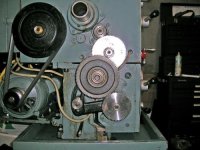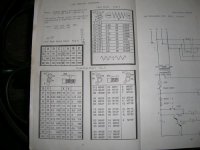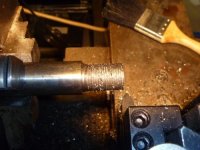OK, you've gotten a bunch of ideas

A bunch of good ideas.
But I'm going to try come in fresh. NOTHING in my post is in reference to any other post here but is directed at the op.
Jerry,
As one who's gone through the same thing over the last 6mo maybe I can give a newb perspective. Like you I have prior "experience" but in my case it was gunsmithing school almost 30yrs ago. Top notch equipment, professionally set up, everything was by-the-book easy-peasy. I was "head of the class" and did real good in school, even went to competition and did well.... until they kicked me out (I wasn't a very good conformist back then either)............. but what I learned about "running machinery" was about as usable as the stuff about "running a business."
Getting your own lathe and dialing it in is a hole nuther canna' worms.
I'm gonna' go off here on another "Alinwa Opinion Rampage" so if'n you're one of those who find my style offensive, oh well. I tried. And if it bores you maybe it'll help someone else.
While I was still in gunsmithing school I met a local guy who had a lathe and did chambering and stuff. He wasn't in the class but we spent time together sharing info. I remember his little belt drive antique table-top lathe. And I distinctly remember thinking "what a piece of crap. He can't POSSIBLY do real quality work. When I get set up I'll have XXXX "Professional" setup and be much better than this hacker."
WHY??? Why you ask did I feel this way?
Because I was an ignorant ASS. I was a student, he was a real man working in the real world and using real equipment. I had "dreams" while he had a real lathe.
So now, thirty yrs later, I too have a little lathe. And it's paid for.
And it's capable of fine work. As was his.
These little lathes though are flimsy and shakey..... the bits are small and poorly supported and heat is always a problem.
So's we need to outsmart them.
We simply CAN'T get by with pulling the stuff that the quarter-million-dollar setups allow. It helps to set down and figure out HOW the tool cuts. For me this means drawing pictures...... (I do this a lot

) ..... links like this one help me to work it out in my head.
http://www.sherline.com/grinding.htm there are many others. We have to learn HOW the tool cuts best and work with it. First of all, the tool wants to cut on only one edge whenever possible, and it wants to "shear" if possible instead of just hooking metal off by main force. And it wants plenty of clearance away from the cutting edge.
Now here's the crux.......
For presentation and clearance you want a long slim needle-like "tooth" like the tip of a chisel. And to present this in such a way that it smoothly peels off steel.
But for strength and more importantly for cooling you need to keep some mass out near that working edge. You sharpen that thing to look like your hunting knife and it'll heat, curl, burn and chip..... and chatter from the get-go because it's too wimpy.
Sooo, you need clearance and beef. Two innovative ways I've seen recently are the Diamond Tool Holder and Bob Pastor's HSS bit system. Both are awesome..... but there are other ways too. For us hobbyists.
Which brings up another point. Most of these guys here are real machinists. They do this stuff for a living and they have good equipment but more importantly they've FORGOTTEN more than you and I know. Really.... they've FORGOTTEN why they know what they know, they just DO IT.
SOOOO, First of all..... let's get into the WHY of the fabled 29 or 29 1/2 degrees......
We do it because we want to cut with only ONE EDGE. Sharpening a bit like the prow of a Viking ship and ramming straight into the cut works OK if your lathe weighs in like a Supertanker, make a lathe stout enough and it'll make threads by displacement if nothing else! A "displacement hull" bit.....But you're looking to sneak in and pull out the excess steel without waking the neighbors, without flexing the system. So's we cut out threads sideways, kinda' sidle into them, extending the rear of the thread back and back while hoping to leave a nicely polished bearing surface.
Let's look at the 29 1/2 degrees......
First of all, from your description you've got it backwards. BUT!!! This doesn't mean it IS backwards, just that I'm reading it backwards. So again, let's draw pixtures. Let's understand what we're trying to accomplish.
Draw threads from right-to-left on the paper, like you're looking down on the cutter bit. Try to make the drawing kinda' accurate so you can see the 30 degrees. Or just PRETEND that it's 30 degrees....... zig-zag zig-zag ziggy zaggy like a sawblade.
Now (look over your shoulder first to be sure no one's watching) cut out a little lathe bit and drive it like a toy truck..... brrrrbrrrmmm brrmmm ...... or use your pencil and pretend it's the cutter bit..... but angles are important here...
Drive it in at 30 degrees. Your feeding it remember
with the compound which is set at 30 (actually 29 1/2) degrees. The bit is advancing SIDEWAYS and in, angled,
not straight in like the cross slide.....so it's only cutting the REAR surface of the thread. It's just rubbing on the right side of the groove, passing by it. ((((Actually, I'm again running a risk using "rear" and "front" but bear with me. I'm calling the surface to the left of the point the "rear."))))
Now change you angle..... Drive it in at 29 1/2 degrees
you gotta' stop and THINK here. 29 1/2 degrees from WHAT????
What you're looking for is a little more clearance. You don't WANT it to be rubbing on the right side of the thread groove. If it's rubbing it's heating up. If it's rubbing and heating up it's wanting to move. It's wanting to gall. it's wanting MORE CLEARANCE. The 29 1/2 degrees is whichever way CLEARS the slope as you advance the compound as opposed to digging into it.
kapische???
We want only ONE SURFACE, one edge doing the cutting.
The other edge is just coasting.....
With pictures it soon becomes apparent that we don't even need a fancy-schmancy 60 degree grind on our bit. ALL we need is an advancing cutting edge that's set at 30* off perpendicular and our compound slide set to 30 degrees (actually 29 1/2... for clearance) and we're getting a nice 60 degree thread BUT ONLY CUTTING ONE SIDE! The left side of the groove.
We're coming in from right-to-left
We're threading from right-to-left
As the thread cuts deeper the advancement is
in and LEFT so that it's only cutting the LEFT edge of the groove or slot. So the bit needs to be ground for the surface it's approaching.
The right side of the bit doesn't matter much.
The LEFT side though is crucial..... and remember the TIP or so-called tip, the cutting edge, is the LEFT SIDE of the cutter bit. If you've figured out how to approach the workpiece for TURNING a nice finish then you must get that same approach on that crucial left side.
I've been playing with grinding parting blades for threading. They're AWEsome for threading up to the shoulder.....And they allow you to extend out and away from the toolpost so's you can play with grind and feed angles. I can actually set up to grind only ONE angle on a parting tool bit and feed in parallel to the blade......
But the kicker is, figure out WHERE the actual cutting edge engages the work and grind to pull steel gently out of the groove and sweep it off the face of the thread. Get the TIP high and remember, the LEFT FACE is the actual cutting edge. It's almost like the "top rake" or the "chip breaker" surface is being used for the cutter face. It cuts the "face" of the left thread back and in.
And you
FEED IN at 29 1/2 degrees to make the other side. NO cutting going on on the right side of the groove.
And the left face if the bit has to have BACK and SIDE rake as well as BOTTOM clearance just like it were the front face. Which it now is.... And the cutting face must CUT AT 30 DEGREES to perpendicular. The rake angle is now the cutter angle.
(((pictures might help??? drawings again!)))
And of course you use the actual cross slide only to reset the operation. And you zero it every time.
This is crucial. the cross slide must be ZERO'D each time.
This is again the sort of step that the real machinists just "know"......
And I do mean
zero'd. any sort of sloppiness when resetting the cross or in feed back to zero wipes out your threads.
I accomplish this by setting the crossfeed handle close and with the handle at the bottom of the stroke, now rotate the dial to zero and go back to it every time. Go back to it FROM THE SAME SIDE OF THE LASH. If you go too far you must back off 10-20-30 numbers and come back in. When you hit the end you back OUT a turn, roll back to start and back IN that exact same turn. Then you advance the compound slide a couple-three or ten thou for your next pass.
Soooo, you get CLOSE with the crossfeed and sneak in to start the cut with the compound. And you do all the cutting advancement with the compound. And when you get CLOSE on the crossfeed make sure you stop it with the hannle on the bottom and zero it. This way your compound feed advances correctly, FROM THE SAME STARTING POINT.
For cutting the even numbered thread you can theoretically drop the threading lever (half nut) on every line but maybe you'd better try simplifying....You can try dropping the handle on exactly the same number every time. And try backing off a little extra far so if your drop misses you have time to ABORT! before hitting steel....
But I really think that once you picture HOW the bit is approaching the surface and engaging the cut it'll start to take shape.
I hope this helps you out.... and if it doesn't just ask me to and I'll (try) to clarify my verbiage.
I tend to get windy.
LOL
But I am getting threads that need very little dressing up.
al
"The person who learns "how" will always have a job. The person who learns "why" will always be his boss."
Diane Ravitch






